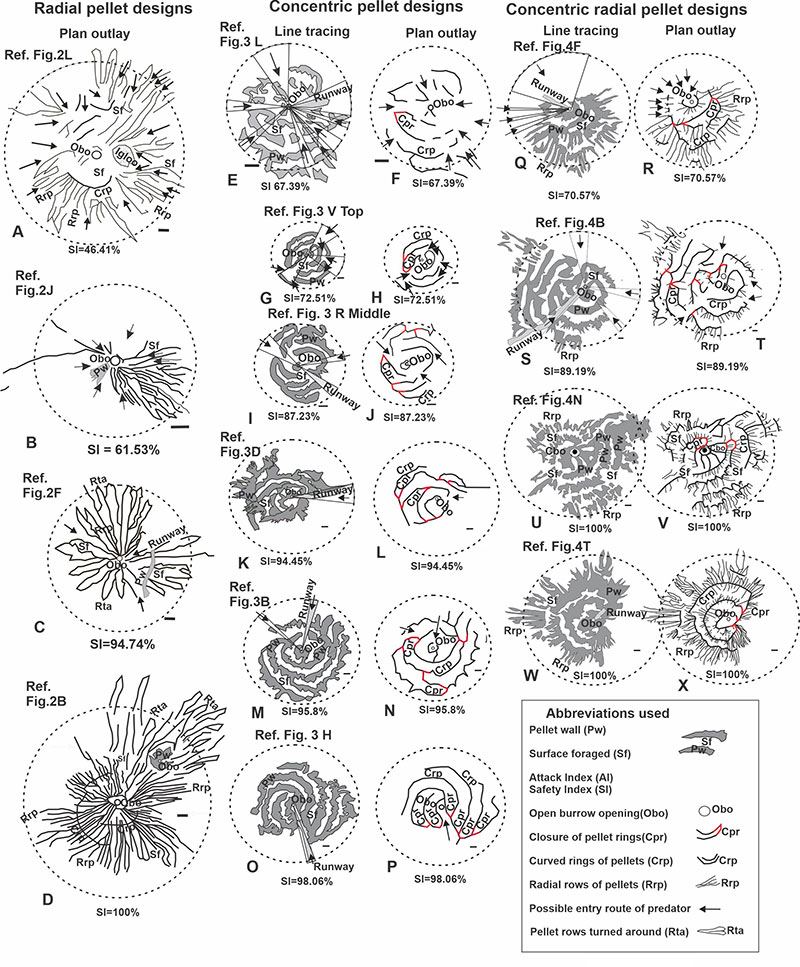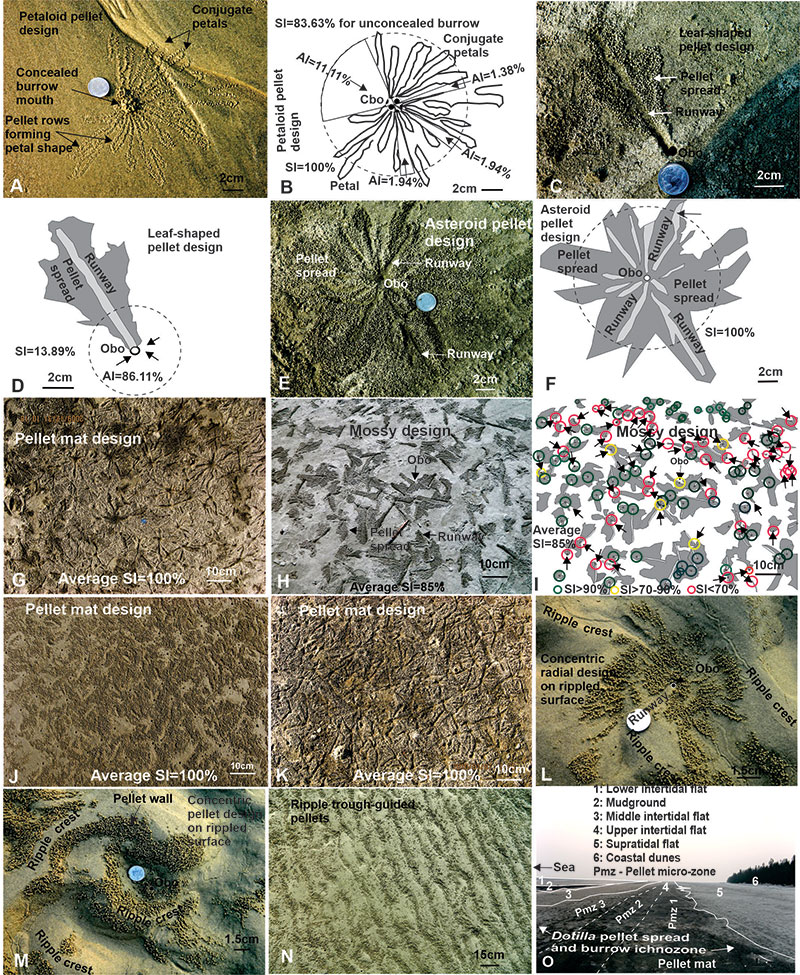FIGURE 1. Different ichnozones and geomorphic features developed in the Bakkhali (21° 33' 50" N and 88° 15’ 49” E) beach of the Bay of Bengal coast, Eastern India (re-mapped in 2015 by the author and modified after De, 2019, 2000). Note field photographs of the pellet making bubbler crabs Dotilla spp. and their burrow casts.

FIGURE 2. Radial pellet structures (A, C, E, G, I and K) produced by the crab Dotilla in the upper intertidal beach of Bakkhali, Eastern India. Corresponding line tracings (B, D, F, H, J and L) are made to calculate Safety Index (SI) and Attack Index (AI). Structures represented by figures I and K suggest early stage of development of radial pellet design and possess lower Safety Index (SI = 61.53% and 46.41%, respectively) compared to other structures (A, C, E and G) that represent later stage of development of radial design and possess very high Safety Index (SI ranging from 100% to 94.74%). Figure G Left represents a juvenile structure and the rest are produced by young and adult Dotilla. Note larger size of feeding areas made by adults (A, E, K) compared to that of juvenile (G Left). A represents a more advanced feeding stage (over larger area) than I (over smaller area). Scale bar equals 1 cm.

FIGURE 3. Concentric pellet design (A, C, E, G, I, K, M, O, Q, S, U and W) produced by the crab Dotilla in the upper intertidal flat of the Bakkhali beach, Bay of Bengal, Eastern India. Figures B, D, F, H. J. L, N P, R, T, V and X represent the corresponding line tracings drawn for measurement of Attack Index (AI) and Safety Index (SI). Note formation of both clockwise and anticlockwise closures of pellet rings (Cpr), pellet walls (Pw), surface foraged (Sf), open and closed burrow openings (Obo and Cbo respectively) and curved rings of pellets (Crp). Figures L, R - left and middle, V - top and Q correspond to concentric designs at early to middle stages of formation and possess relatively lower SI values (67.39%, 88.34%, 87.23%, 72.51% and 84.73% respectively) than the other nearly fully developed structures (SI varying between 98.06% for d to 91.04% for j). Compare size of the feeding territory between Figure I (larger for the adult) and U (smaller for the juvenile). Note SI attains 100% value for pellet designs having closed burrow opening (Cbo). Arrow heads in line tracing Figures point to possible entry routes of predators or enemies of Dotilla. Scale bar equals 1 cm.

FIGURE 4. Concentric - radial pellet design (Figures 3 A, C, E, G, I, K, M, O, Q, S, U and W) produced by the crab Dotilla in the upper intertidal flat of the Bakkhali beach, Bay of Bengal coast, Eastern India. Figures 3 B, D, F, H, J, L, N, P, R, T, V and Xl represent the corresponding line tracings made for measurement of Attack Index (AI) and Safety Index (SI). Figures Q and W represent conjugate concentric - radial structures made by several individuals and possesses shared concentric rows of pellets (Scrp) and very high Combined Safety index (CSI) of 97.23% and 98.33% respectively. Note the majority of the structures are made by young and adults and rarely by juveniles (example Figure 4 E, G). Also note that pellet design at the earlier stage of development has lower safety index (SI) than those in the advanced or final stage of development (SI 70.57% for Figure C vs. 100% for Figure 4 O and S). Note that structures with closed burrow opening have SI value 100% (Figure 4 G and M). Compare size of the feeding territories between A, M, O (larger for the adults) vs E (smaller for the juvenile). Scale bar equals 1 cm.

FIGURE 5. Plan outlays for the radial, concentric and concentric-radial pellet designs produced by the bubbler crab Dotilla have been drawn from the corresponding line tracings (as referenced in each case) to highlight how structural elements are constructed to enhance burrow protection. For radial designs dense radial rows of pellets (Rrp), curved rings of pellets (Crp), pellet walls (Pw) and turned around pellet rows (Rta) are increasingly added to the structure to increase the Safety Index (SI) by closing or cutting off the probable routes of entry of the predators into the burrow openings. Note plan outlays A to D depicting gradual increase in SI values from 46.41% to 100%. Plan outlays (F. H, J, L, N and P) corresponding to the concentric pellet designs show that addition of concentrically oriented curved rings of pellets (Crp) and formation of clockwise and anticlockwise closures of the pellet rings (Cpr marked by red lines) are two basic measures taken by the crabs to enhance SI (compare the plan outlays from E to J where SI values have improved from 68.39% to 98.06%). Note that for concentric-radial designs, as displayed by the plan outlays (R, T, V and X), all the above measures, besides formation of outgoing radial pellet rows from curved rings of pellets (Crp) that act as innumerable barriers for the predators to sneak through spaces between curved rings of pellets, are taken to improve SI values (compare 70.57% for Q to 100% for W).

FIGURE 6. Other pellet structures produced by the crab Dotilla on the upper intertidal flat of the Bakkhali beach, Bay of Bengal coast of Eastern India. (A) Petaloid pellet design produced by petal shaped radial rows of pellets and conjugate petals formed around burrow opening. (B) The line tracing corresponding to A shows SI value 100% as the burrow mouth is closed. (C) Leaf-shaped pellet design and (D) its corresponding line tracing shows very poor SI value (13.89%). (E) Asteroid pellet design contains several radiating runways that are well enclosed within the pellet spread areas and (F) its corresponding line tracing shows 100% SI value. (G, J and K) Different stages of formation of pellet mat design in pellet - microzone 1 wherein entire surface is covered by dense population of pellets leaving no space for the predators to sneak into burrow opening (SI = 100%). Note high population density and small size of the pellet designs. (H) Mossy pellet design formed by the crab community. Several burrow openings and corresponding runways are partially to fully covered by pellet spread zones. (I) Line tracing shows variable SI values of the individual structures (marked here by red, yellow and green circles having SI values <70%, 70% - 90% and > 90% respectively) averaged at 85% for the community structure. Arrows indicate possible entry routes of predators into the burrows. (L and M) Concentric radial and concentric pellet structures formed on rippled surface. (N) At times, pellets are formed selectively along the ripple troughs. (O) Beach profile showing extends of lower, middle and upper intertidal flats, besides mudground, supratidal flat and coastal dunes. Note smaller size of the structures (G, H, J, K) due to increased population density and predation pressure.

FIGURE 7. Feeding strategies and progressive growth of the Dotilla pellet structures. Note four types of feeding modes: sector (of a circle) feeding mode covering growth (top to bottom) of the pellet structures arranged in four columns (1-4) corresponding to four different types of pellet designs (homogeneous pellet spread, radial, concentric and concentric-radial); radially diverging feeding mode covering growth (top to bottom) of the radial and asteroid pellet designs (column 5); concentric feeding mode covering growth (top to bottom) of the concentric pellet designs (column 6) and combined concentric-radial feeding mode covering growth (top to bottom) of the concentric-radial pellet design (column 7). Note development of different designs under sector (of a circle) feeding mode within feeding sectors having similar shape and size (column 1- 4 top structures). Also note a pellet design may originate in different feeding modes, but with subtle differences. The lower half of the figure incorporates schematic representation of the growth stages (I - Initial, M - Middle, F - Final from top to bottom) of all the above pellet designs with time and progressive feeding activity under different feeding modes (columns 1-7 are extended from upper to lower half of the figure to maintain analogy). Also note for each schematic structure (not to scale) presented, there is a physical (natural) analogue recorded from the field. Also visualize the growth of structural complexities, acquisition of described barrier elements and SI index along each column from top to bottom in both the natural and schematic presentations.

FIGURE 8. A: Ex situ preservation (aided by wind action) of Dotilla pellets as pellet-filled burrow tubes in the supratidal flat during low tide situation. B: Ex situ preservation of Dotilla pellets (aided by wind action) in ripple troughs during low tide situation. C: Schematic profile section of the studied beach showing positions of the Dotilla pellet spread and burrow zone, spread of Ocypode burrows, mutual dispositions of different geomorphic units (dune, supratidal, upper - middle intertidal flats) relative to land - sea positions and High and Low Tide Levels (HTL and LTL). Note gradual spreading of the Dotilla pellet and burrow zone towards sea with gradual lowering of substrate water levels (WLs) during tidal recession of sea. D-E: Possible stratigraphic development of the coastal sedimentary units (1-3) and contained burrow zones and other associated features in transgressive (E) and regressive (D) situations. Note the possible position of preserved Dotilla pellets and burrows between Unit 1 and 2 under transgressive-regressive sea conditions. Features are schematic and not to scale.


